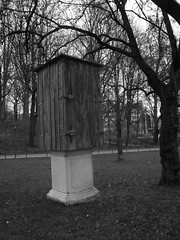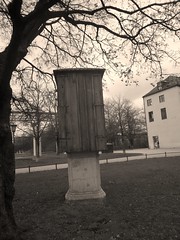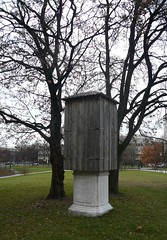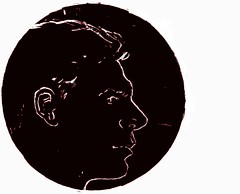cabin monument
A particular naming can transform a find to something we used to call a "work of art". The name for this conceptual construction would be "Gaze Monument". We name "Gaze Monuments" conscious transpositions of objects to unexpected areas. Sudden descriptions that are proved similar to constructions. Some things (that could already be writings) explode and reach areas "in which they don't belong"; they then are structurally formed as "gaze monuments". Either provocatively, as here for instance, or silently, objects can be proved the testimonies of "other discourses". The object, an action, a composition or any element installing reality "as such" can undertake the role of a particular definitive transformation. The work of this transformation would be a conscious change of meaning of the element. A Gaze Monument would than be the disturber that disarranges the symbolic order of things. Showing it as a non ordinary piece may already formulate a sabotage strategy.




A metaphoric structure could be for example obvious in the "cabin monument", found during a walk in Munich, 2009: it maybe expresses the possibility of different inhabitations proposed for a stable marble basis. The piece can be shown as an open possibility of hosting whatever statue in the same place. A possibility of a monumentality for replacement could be at stake. We can remember Lenin's first politics of monuments that prescribed wooden sculptures or provisional honorary sculptures for the acts or the heroes of the revolution.
Is the Cabin Monument an empty monument or does it shape the structure of the monumental? The Cabin Monument could be presented for instance as a quest for investigation about the ethical construction of memory. From another point of view the Cabin Monument pose this inverse question: can we think of ethics without memory? Can a provisional monumentality form an enough strong foundation for future ethics? Can ethics exist without a strong, monumental, symbolic order? The Cabin Monument could be a paradoxical word, pronounced in a non existing language or it could function as a particular question; as a destabilizing fragment of reality, in the same time obviously included in reality's most banal side. The transformation of some forgotten objects into important things is a silent work; it is the production of a particular recognition or a perverse reference that can substitute the work of art with a construction of the gaze. Such constructions, such intellectual distortions can form a series of steps in a city level. The city would then be an idiosyncratic museum of banality. Nevertheless such a museum is more a museum of seeing. A "gaze monument" would mark a responsibility for seeing. In the same time it does not require more creative energy then the distorting power of any intellectual occupancy.




A metaphoric structure could be for example obvious in the "cabin monument", found during a walk in Munich, 2009: it maybe expresses the possibility of different inhabitations proposed for a stable marble basis. The piece can be shown as an open possibility of hosting whatever statue in the same place. A possibility of a monumentality for replacement could be at stake. We can remember Lenin's first politics of monuments that prescribed wooden sculptures or provisional honorary sculptures for the acts or the heroes of the revolution.
Is the Cabin Monument an empty monument or does it shape the structure of the monumental? The Cabin Monument could be presented for instance as a quest for investigation about the ethical construction of memory. From another point of view the Cabin Monument pose this inverse question: can we think of ethics without memory? Can a provisional monumentality form an enough strong foundation for future ethics? Can ethics exist without a strong, monumental, symbolic order? The Cabin Monument could be a paradoxical word, pronounced in a non existing language or it could function as a particular question; as a destabilizing fragment of reality, in the same time obviously included in reality's most banal side. The transformation of some forgotten objects into important things is a silent work; it is the production of a particular recognition or a perverse reference that can substitute the work of art with a construction of the gaze. Such constructions, such intellectual distortions can form a series of steps in a city level. The city would then be an idiosyncratic museum of banality. Nevertheless such a museum is more a museum of seeing. A "gaze monument" would mark a responsibility for seeing. In the same time it does not require more creative energy then the distorting power of any intellectual occupancy.





No comments:
Post a Comment